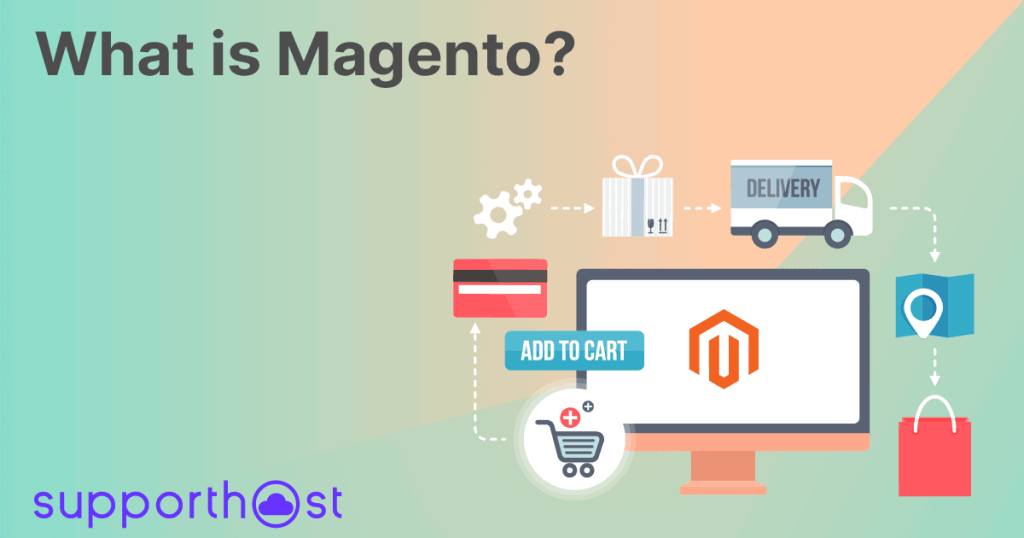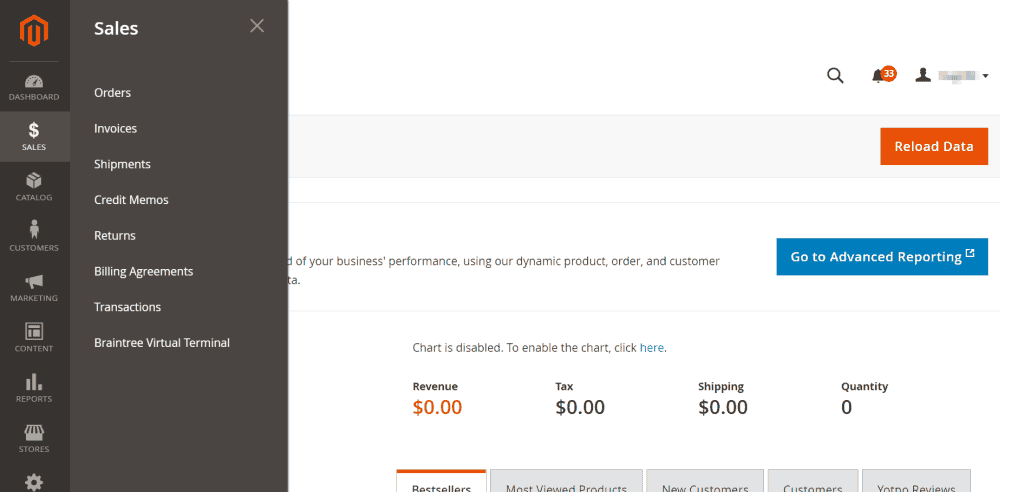In this article, What is Magento?, we are going to find out what Magento is, how it has evolved since its first version and how it has managed to get a slice of the market among ecommerce CMSs.
We will go over the differences between Magento 1 and 2 and see which features distinguish the Open Source version of the platform from the licensed version, Magento Commerce.
To begin, let’s take a look at how Magento came about and how many sites use this content management system.
Table of Contents

What is Magento?
Magento is an ecommerce platform written in PHP, the platform was created in 2007 and the first version was released in 2008.
The development company, Varien, initially created the platform as a fork of osCommerce. In short, the project turned out to become a platform in its own right and managed to outperform osCommerce.

Another turning point came in 2015 with the release of the Magento 2 version and then in 2018 with the purchase by Adobe.
Now that we’ve covered the milestones in the history of this platform, from its inception to its acquisition by Adobe, let’s look at its current state and how Magento is positioned against the alternatives.
Magento and other ecommerce platforms.
When choosing to create an ecommerce website, one of the biggest challenges is choosing the right platform.
What are the alternatives to Magento and what are the main solutions adopted by ecommerce site builders on a global scale?
Looking at the statistics of buildwith for ecommerce, we can find out who stands out from the Magento vs Woocommerce comparison, at least by percentage of use.
From the latest statistics updated as of March 22, 2022, for ecommerce we find WooCommerce at the top with 28% of sites out of 318,103 sites surveyed using CMS for ecommerce.
It is followed by Shopify with 20% and Magento with 8%, with the remaining 44% using other platforms.
In the most widely used platforms for ecommerce sites, and specifically in the battle between the top three solutions Magento vs Shopify vs WooCoommerce, Magento ranks third.
Now that we have seen that it is one of the most widely used platforms for ecommerce, let’s see what is Magento? and what its main features are.
What is Magento: an overview
To better understand the features of this platform we need to go and compare its versions: specifically the two main ones known as Magento 1 and 2.
We must, in addition, make a distinction between the Open Source version to the licensed version, known as Magento Commerce or more recently as Adobe Commerce.
Firstly, however, let’s see what the main features of the CMS are.
Magento: the characteristics of the platform.
To answer the question “what is Magento? ” we can say that it is a platform that was created for the creation of ecommerce sites and, because of this, it already includes essential features and tools to open an online store.
The variety of functions included in systems created specifically for ecommerce like Magento make these platforms the ideal choice when you need a lot of additional features.
In systems as diverse as WooCommerce, adding plugins to extend features could weigh on the speed of WooCommerce. Therefore, when you create an ecommerce site, the choice of platform is important and you should start precisely by identifying the functions that will be essential for your project.

Magento features include integration with major payment methods, tools for catalog management, inventory creation and order management.
There is also support for localization and handling different currencies, as well as the ability to analyze sales statistics by accessing different reports.
There is no shortage of Google Analytics integration and a number of features that allow you to optimize your site for search engines, such as the ability to generate a sitemap and to modify alternative attributes for imgage optimization SEO. These are just some of the features of the CMS, but to better understand what Magento is and what it can offer us, let’s go and see what differences there are between Magento 1 and 2.
If, on the other hand, you’re interested in comparisons with other CMSs, check out our article on Magento vs PrestaShop.
Magento 1 and Magento 2 compared
The move to Magento 2 has resulted in improvements in performance, extension compatibility, admin panel, and mobile optimization.
Let’s take a closer look at these aspects to understand what Magento 2 is and what new features it has introduced compared to the first version of the CMS.
Magento 1 vs Magento 2: performance.
Magento 2 has given a performance boost. Where the first version had shortcomings, significant improvements have been made since version 2.
According to Adobe’s data, switching to Magento 2 results in a 20% improvement on website speed. Improvement measured in comparison to sites with Magento 1.
As you may know, having a fast site is important for both the search engines and the user experience on the site.
Just this advantage should be a valid reason to choose Magento 2, but let’s see what are the other features introduced by the new version.
Magento 2 also introduced support for several tools. We find Composer, to use third-party libraries, Symfony that allows extended functionality, Redis and Varnish to improve site speed, and support for NGINX.
Mobile optimization
As the number of purchases made from mobile devices increases, having a mobile-friendly site is not only mandatory for blogs and corporate sites, but even more so for ecommerce sites.
This is why the new version of Magento is designed to be better optimized on mobile devices than Magento 1.

Also note that, starting with Magento 2.3, is the support for Progressive Web Application with PWA Studio.
Mobile optimization has a twofold advantage: on the one hand it meets the needs of users who are faced with a fully functional site even from mobile devices. On the other it meets Google’s guidelines in the Mobile-First Indexing perspective. With the revolution taking place, starting in 2019, the mobile version of the site is taken as the reference for indexing.
Interface
The release of Magento 2 was also an opportunity to implement a simplified interface and thus provide users with a better experience. If, in fact, Magento 1 had an administration panel that could be complex to use, improvements were made in the next version.

A simplified interface results in time savings for those who manage ecommerce and need to quickly access tools.
Extensions
With Magento 1 there were some compatibility problems with third-party extensions. With the switch to Magento 2, it is easier to install extensions and also some features have become part of the CMS core.
Checkout process and payment gateway.
The checkout process has been simplified, and with Magento 2, the instant purchase function has also been introduced.
With Magento 1, six steps were required to get to complete the checkout, from method selection to order summary. Now with Magento 2 only two steps are required: the first for shipping information and the second to review and confirm payment.

Magento 2, moreover, also introduces the possibility of instant checkout, allows you to store payment and shipping information and simplify the sales process.
Simplifying the checkout process can make a difference in sales and improve conversion rates. Just remember that from a survey published in Baymard and updated in 2022, 17% of cart abandonment cases are due to overly long or complex checkout processes.
Magento 1 required third-party integrations, while with Magento 2 major payment gateways are supported.
Support and security
Last but not least, there is the issue of support. As of June 2020, support has been discontinued, so updates and security patches are no longer released.
This means that continuing to use a version of the CMS that is no longer supported can expose your site to vulnerable risks.
Magento Open Source and Magento Commerce compared
When we talk about what Magento is, we have to make a distinction between two different solutions: Magento Open Source and Magento Commerce.
Keep in mind that the Open Source version was also known as Magento Community Edition.

Magento Open Source
The Open Source version of Magento is a free platform that can be used by choosing a suitable and optimized hosting.
The requirements of this CMS uses a tailored configuration to ensure performance. For this reason, Magento hosting has specific features to give you the best performance with Magento 2.4.
Depending on the plan you choose, your site will be hosted on a cloud VPS or on a managed server.
If you have specific questions about the service, please feel free to contact us.
Magento Commerce
On the other hand, we have Magento Commerce, which in turn comes in two versions. Magento Commerce “On-premises” is an extended version of Magento Open Source, initially known as Magento Enterprise Edition.
In this paid version, additional features are available, which we will see in a moment in our Magento Open Source vs Magento Commerce comparison.
Then there is the cloud version, including hosting with Azure or Amazon AWS, also known as Adobe Commerce Hosted Cloud.
Note that Magento Commerce as of April 2021 has become Adobe Commerce, in this article we will refer to the service by calling it Magento Commerce.
Integrated functions
Magento Commerce and Magento Open Source, as of version 2.4.3 feature the same Page Builder although with slight nuances and differences.
In fact, with Magento Commerce you can also access additional management tools.

Magento Commerce features include advanced tools for B2B, customer management and support, and analytics and marketing functions are included.
Costs
Magento Open Source is a free platform, which means that using the CMS does not require licensing fees.
Therefore, one must consider only the costs of bringing the site online and then those for the registration of the internet domain and for hosting. Of course, the costs of developing and managing the ecommerce must also be added to these.
Magento Commerce and Magento Commerce Cloud involve an annual license that is priced only upon request. Costs start at approximately $22,000 per year, but vary depending on the project.
Support
With Magento Commerce Cloud, technical support is included, while as for Magento Open Source you can rely on the community and as for hosting you can refer to the hosting support offered by the provider.
Conclusion
In this article, What is Magento?, we took a look at Magento and what functions it can offer us with the new Magento 2 version.
In addition to reviewing the main features of the CMS and comparing Magento 1 and 2, we compared the Open Source version of the CMS with Magento Commerce, the licensed version that is also available with hosting included.
Did you already know the features of this CMS and the different solutions available? Let me know in the comments below.





Leave a Reply